What is a Project Management Environment?
- January 20th, 2022
-
Community Spotlight
- Swarm Digital
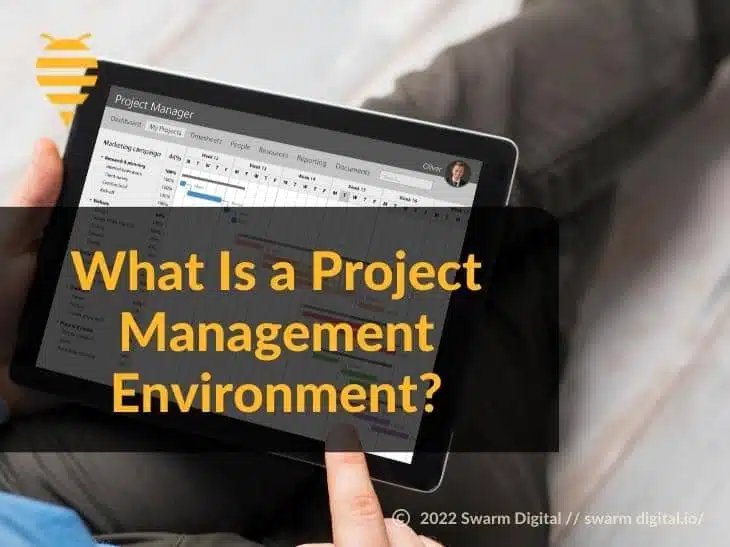
Whenever you have a group of people working on finishing something, you have a project management environment (PME). We’re big on PMEs here at Swarm Digital. Why? Because they help us help you get projects done efficiently, clearly, and excellently. In this article, you’ll learn what they are, their benefits, what they look like, and what to expect from them.
How PMEs Work
Everybody has a system. If you walk around any typical workplace, you see as many systems as you do human beings. Some manage their lives through their phones and watches: notes, to-dos, texting, cloud-based productivity apps. Others keep it simple: a Franklin Covey planner, index cards, brainstorming on a Moleskine.
Project management is about bringing people and systems together to get work done. The process can go from pen-and-paper simple to devastatingly obscure. There are about four trillion systems out there, and they use terms like Gantt, Kanban, stakeholders, dependencies, deliverables, scope creep, and critical path method.
Yet everything about project management, complex terminology and all, springs from a simple idea:
The team has something to do–a project with a beginning, middle, and end. They need to get it done coherently: there can’t be a billion work systems cluttering up everyone else’s productivity. They need one place to evaluate work in progress. The team also needs clear expectations and deadlines. And they need to talk via the same channels.
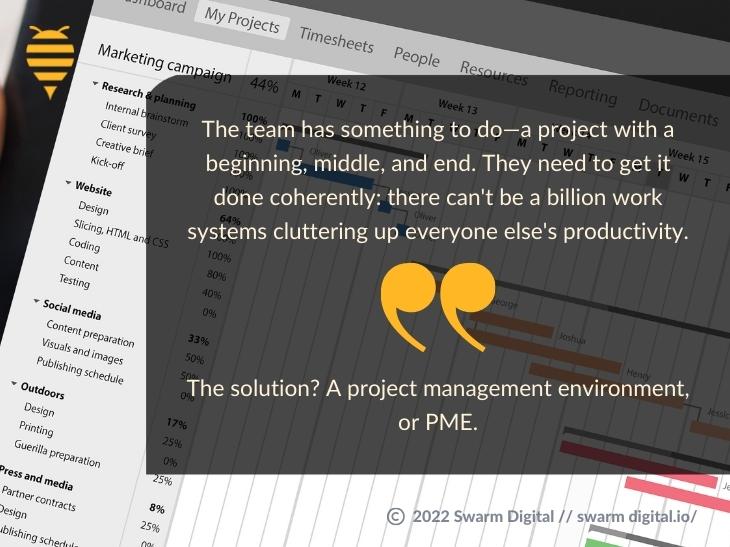
The solution? A project management environment, or PME.
The Benefits of Working in a Project Management Environment
Whether you’re designing microchips, bringing a book to publication, constructing a skyscraper, or getting a website to a client, a project management environment can help create a smooth workflow and clear expectations for everyone. They work in-person and when working remotely. Consider these benefits of a streamlined project management environment:
Simplicity
One of the benefits of a PME is that it helps everyone work using the same tools. Some examples: one colleague writes in Microsoft Word, while another writes in Google Docs–which works great until you’ve got obscure formatting issues that take hours to work through. One colleague hates email, while another has an annoying habit of sending work messages over Facebook (ugh). A PME puts work in one place, within one system.
Organization
You know those meetings. Someone missed a deadline. Someone else shouts that the deadline was clearly communicated via an email sent on a Saturday afternoon six weeks ago. Hijinks ensue; feelings are hurt; morale stinks; the project is in disarray. How do you keep that from happening? You can’t always prevent it, but a functional project management environment helps keep expectations, deliverables, and more crystal clear.
Measurement
One of the great benefits of a well-managed PME is measurement–knowing who’s doing what and where, your colleagues’ progress, who has what task for what deadline, and more. PMEs can help manage your most important resources: people, time, money, and more.
People Management
Teams are people. The goal of a PME isn’t to turn people into statistics; instead, it helps the team see where people are performing in relation to the project. If someone’s sick and can’t meet a deadline, you can know within the project management environment and reallocate resources from there.
Clarity
The most significant benefit of a good PME is that it takes the many disparate elements of a project and puts them all in one place. The result: an environment where you can make decisions, maximize resources, and most importantly, lead.
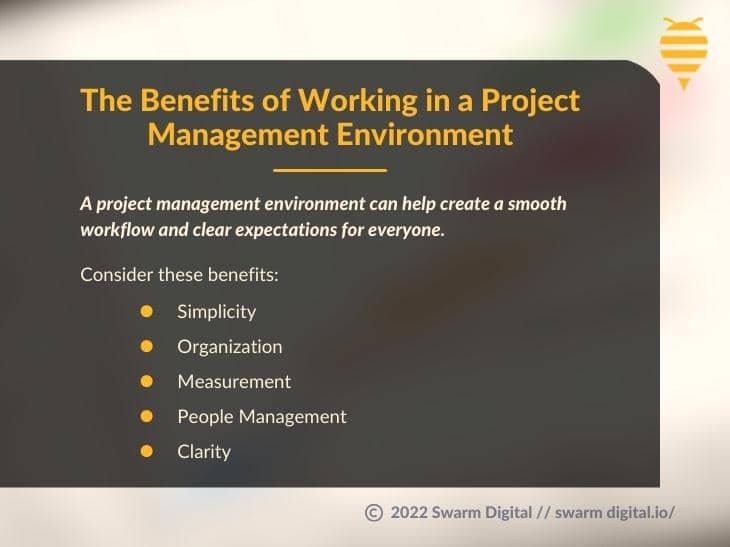
Apps for a Project Management Environment
Can you do project management without an app? Yes. For the sake of this article, we’re sticking to software used to create and administer team-based work in progress.
A project management app is a tool designed to get everyone involved on the same page and keep them there. Like most tools, there’s a mammoth amount of variety: simple to complex, shallow to deep, specialized to comprehensive. In general, they have a specific set of elements that help keep the team on track.
What A Project Management Environment Looks Like
Remember—there are as many systems as there are people. As a result, it’s vital to have an orderly environment where all project elements can be managed and controlled. You need to know where and how to access–easily–your scope, timeline, budget, and goals.
A typical project management environment includes the following elements:
Messaging
In the mid-2000s, work was disrupted catastrophically by two forms of communication: social media and texting. Some work environments, especially less-structured ones like entrepreneurship, lost coherence. Facebook Messenger might be used to share mission-critical file attachments. Structured hourly work dissolved into midnight off-the-clock texting sessions. A PME keeps all that communication in one place so that work is work and life is elsewhere.
Tasks
Activities and tasks can be managed entirely within a good project management environment. That means deadlines, outlines, expectations, checklists, milestones, goals, budgets—everything that could possibly be recorded.
Calendar
A PME should be a place with its own calendar. While many workplaces integrate with Outlook and Google, it can be helpful to have an isolated software environment where milestones are parceled in a way that everyone understands.
Files
Projects can involve a broad spectrum of file types. Let’s use a website design project as an example: HTML 5 code, Google Docs from a copywriter, PNG graphic files, video in MP4, and more. A PME app keeps it all in one place.
Stakeholders
You can’t pack people into an app. A well-organized online project management environment, though, has a list of the people involved and makes it easy to message them. Most also include a live chat feature similar to Slack.
Software
Okay, an app is software. The point of including this on the list is that one software brings clarity and coherence–the team uses one tool, not several.
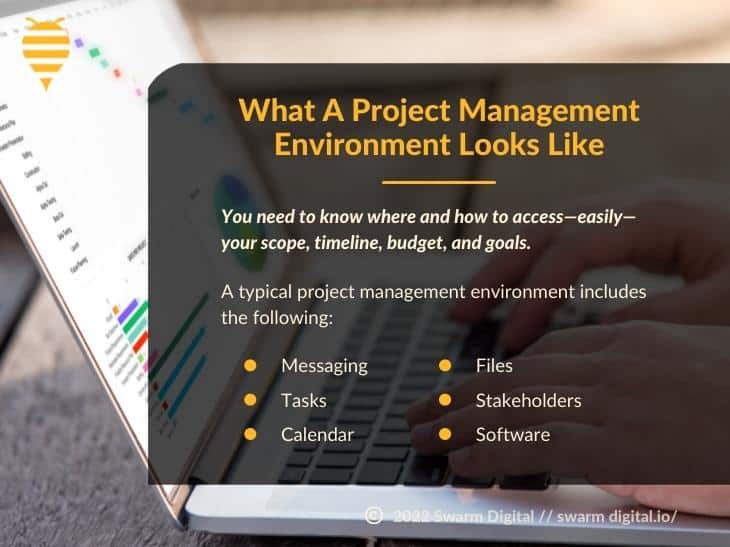
Most Popular Project Management Apps
There’s a shocking amount of project management software out there. We’ve listed five below. By no means is this list comprehensive. It doesn’t include apps for specific project management disciplines–no Kanban-only apps, no timeclock-only software. Some might say, for example, that Google Office can be used as a fully-functional project management environment. Yeah, maybe–but we want to be specialized here.
Basecamp
This is one of the apps we use at Swarm Digital. It’s one of the oldest and most well-respected online project management environments. Tasks, stakeholders, files, communication–they’re all managed efficiently and cohesively. They have a great app; their cloud-based system is exceptionally functional. With over three and a half million users, it’s a trusted PME.
Monday
Relatively new but supported by tons of hype (has anyone else seen like a hundred Youtube ads for this company?), Monday boasts a gorgeous environment, tremendous scalability, and a seemingly endless feature set. It’s relatively inexpensive, popular, and visually beautiful.
Microsoft Project
A fully functional, ubiquitous app, Microsoft Project has the tremendous disadvantage of being a Microsoft Product. To many end-users, that means a lot of time combing online help pages trying to figure out how in the world to use the thing. While it’s tremendously powerful, it’s just not as sexy as some of the other options presented here.
Trello
Intuitive, chart-based Trello has its niche and nails it. If you’re looking for basic PME, Trello might fit the bill for you.
Meistertask
Easily the coolest name on this list, Meistertask is designed to help users manage projects in a way that’s intuitive, visual, and fun. Some reviewers complain it can get a little cluttered and that its calendar feature is lacking.
There are tons of other popular PMEs, including Wrike, Zoho Projects, Smartsheet, Asana, Casual, Omniplan, Podio, Notion, and more. When evaluating software for project management, it’s best to assess your needs first and then identify an app that best fits your particular project.
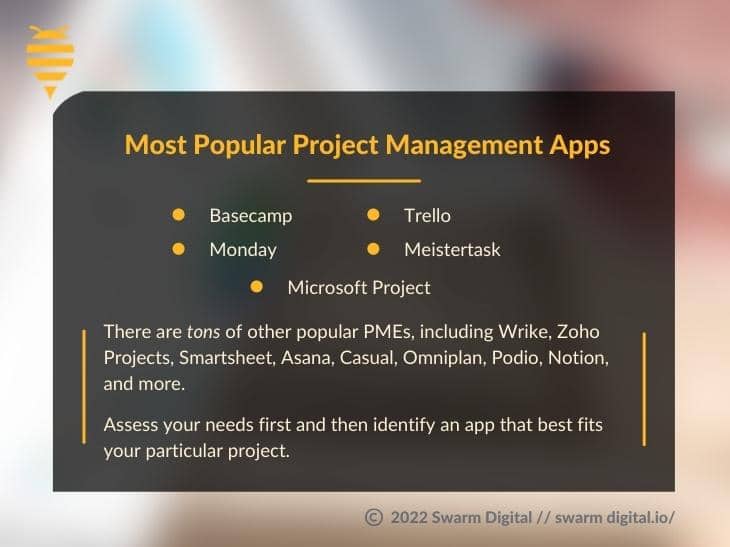
Conclusion
Everybody has a system. Work gets done better when the system is as unified as possible. One of the best ways to get teamwork done is to utilize a project management environment tool. The benefits? Coherence, streamlined collaboration, a clear and isolated workflow, optimized communication.
Is software the best solution? Maybe not–but especially in a post-pandemic world, project management software can help us work well with others, even at a distance. The best project management app? There’s no ‘turnkey’ solution, but there’s an app out there for you.
If you want a team that knows project management and can help you achieve your marketing goals, call Swarm Digital. We’re highly experienced in working within project management environments. Your project manager will be an expert. You’ll have access to our process and workflow, receive tutorials for using the software, and our team will assist you every step of the way. We position you to win at marketing, SEO, and more.
